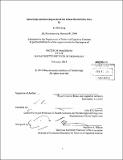Selectivity and development of the visual word form area
Author(s)
King, Li-Wei
DownloadFull printable version (7.950Mb)
Other Contributors
Massachusetts Institute of Technology. Department of Brain and Cognitive Sciences.
Advisor
John D.E. Gabrieli.
Terms of use
Metadata
Show full item recordAbstract
An area of left occipitotemporal cortex commonly referred to as the visual word form area (VWFA), has consistently been shown to activate during the processing of written language. However, the exact nature of the region's selectivity is still under debate. In this thesis, I explore the selectivity of the visual word form area at three different levels. First, I examine whether the VWFA differentiates between letter strings of different lexicality and pronounceability and argue that the VWFA's selectivity is greatly influenced by attention. Second, I explore the developmental course of mirror discrimination in the VWFA, and show that children do not display adult-like mirror discrimination of letters even into early adolescence. Finally, I look at the developmental course of VWFA selectivity for words compared to nonlinguistic visual stimuli. While children have adult-like activation patterns when words are compared to a low-level visual control, they show less specialization compared to adults when objects are used as a control.
Description
Thesis (Ph. D.)--Massachusetts Institute of Technology, Dept. of Brain and Cognitive Sciences, February 2013. Cataloged from PDF version of thesis. "February 2013." Includes bibliographical references (p. 95-113).
Date issued
2013Department
Massachusetts Institute of Technology. Department of Brain and Cognitive SciencesPublisher
Massachusetts Institute of Technology
Keywords
Brain and Cognitive Sciences.